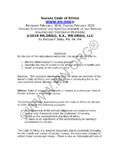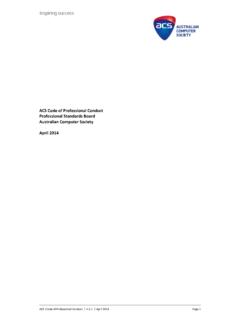Transcription of A Code of Ethics for Psychology - SAGE Publications Inc
1 2 CHAPTER 1A code of Ethics for PsychologyHow Did We Get Here?In a field so complex, where individual and social values are yet but ill defined, the desire to play fairly must be given direction and consistency by some rules of the game. These rules should do much more than help the unethical psychologist keep out of trouble; they should be of palpable aid to the ethical psychologist in making daily decisions. Hobbs (1948, p. 81)BeginningsThe American Psychological Association (APA) has had more than five decades of experience constructing and revising an Ethics code that strives to reflect both the aspirations and practical aspects of ethical decisions made by members of the pro-fession. The creation and each subsequent revision of the APA Ethics code has been driven by the desire for standards that would encourage the highest endeavors of psychologists, ensure public welfare, promote sound relationships with allied pro-fessions, and promote the professional standing of the discipline (Hobbs, 1948).
2 Discussions within APA regarding the need for an Ethics code in Psychology arose in response to an increase in professional activity and public visibility of its members before and after World War II. During this period, the societal value of the still young discipline of Psychology was evidenced as psychologists developed group tests to help the armed services quickly determine the draft eligibility of young men in wartime and provided mental health services to hospitalized soldiers when they returned home. In 1947, the first APA Committee on Ethical Standards for Psychologists was appointed. The committee, chaired by Edward Tolman, Chapter 1 A code of Ethics for Psychology 3wanted to create a code of Ethics for psychologists that would be more than a document with an imposing title (Hobbs, 1948).
3 The members were committed to producing professional standards that would provide psychologists with a set of values and practical techniques for identifying and resolving moral achieve these goals, the committee decided to draw on the knowledge of the field to create a process of developing a code that would be effective in modifying human behavior (Hobbs, 1948, p. 82). According to Hobbs, This is an old and familiar task to psychologists, their very stock in trade, in fact. The only difference here is that human behavior means specifically the behavior of psychologists (p. 82). Drawing on the knowledge of group processes during that period, the com-mittee conceived the task of developing ethical standards as one of group dynamics (Hobbs, 1948). The process chosen was the critical incident method (Flanagan, 1954), a technique that involved asking the members of the APA to describe a situ-ation they knew of firsthand, in which a psychologist made a decision having ethi-cal implications, and to indicate the ethical issues second committee, chaired by Nicholas Hobbs, reviewed more than 1,000 such incidents submitted by APA members.
4 The committee identified major ethical themes emerging from the incidents that focused on psychologists relationships with and responsibilities to others, including patients, students, research partici-pants, and other professionals. Many of the incidents reflected the political climate of the postwar period, including confrontations between academic freedom and McCarthyism and dilemmas faced by psychologists working in industry asked to design tests for the purpose of maintaining racial segregation in the workforce. As different segments of the code were created, drafts were submitted to the mem-bership for critique and revision. A final draft was adopted by the APA in 1952 and published in Preceding the 2010 Ethics CodeAt the time of the adoption of the first Ethics code , continual review and revision based on the experience and perspectives of members was seen as integral to main-taining the value of the Ethics code for both the profession and the public (Adkins, 1952).
5 As a result, the Ethics code of the APA has undergone eleven revisions since 1953. The 1953 version was more than 170 pages long and included case examples illustrating each ethical standard. The standards themselves were written broadly, using aspirational rather than narrow legalistic language. Subsequent revisions eliminated the cases from the text itself and moved toward more specific the beginning of its more than 50-year history, each revision of the APA s Ethical Principles of Psychologists and code of Conduct has been guided by the following objectives (Hobbs, 1948): To express the best ethical practices in the field as judged by a large represen-tative sample of members of the APA To reflect an explicit value system as well as clearly articulated decisional and behavioral rules4 PART I INTRODUCTION AND BACKGROUND To be applicable to the full range of activities and role relationships encoun-tered in the work of psychologists To have the broadest possible participation among psychologists in its devel-opment and revisions To influence the ethical conduct of psychologists by meriting widespread identification and acceptance among members of the disciplineAspirational Principles and Enforceable StandardsAt its heart, an Ethics code should reflect the moral principles underlying the values of the profession.
6 For most professions, ethical behaviors are generally those that fulfill the fundamental moral obligations to do good, to do no harm, to respect others, and to treat all individuals honestly and fairly. For some, statements of gen-eral principles are sufficient to guide the ethical behavior of persons devoted to the ideals of their profession. For others, however, statements describing specific types of behaviors that meet these ideals are necessary to maximize the code s utility and to provide a means of evaluating its efficacy (Schur, 1982).The form in which ethical guidelines are written will determine whether an eth-ics code is an aspirational or enforceable document. Although all codes should have a foundation in moral principles, the document can take one of three forms. An aspirational code is composed of statements of broadly worded ideals and princi-ples that do not attempt to define with any precision right and wrong behaviors.
7 An educational code combines ethical principles with more explicit interpretations that can help individual professionals make informed decisions in morally ambigu-ous contexts. An enforceable code includes a set of standards that specifically describes behaviors required and proscribed by the profession and is designed to serve as a basis for adjudicating grievances (Frankel, 1996).The original APA Ethics code , and seven revisions that followed up to 1990, gradually combined statements of aspirational principles with general guidelines and enforceable standards for ethical behavior. During this period the increasing legalistic reaction of consumers and psychologists involved in charges of ethical violations by psychologists raised concerns about the fairness of subjective inter-pretations of such broadly worded principles and standards.
8 Moreover, a rise in the number of appeals to decisions made by the APA Ethics Committee and regulatory bodies ( , state licensing boards) that relied on the APA Ethics code for their disciplinary procedures suggested that adjudicatory decisions based on this type of format would be increasingly difficult to enforce and thus a disservice to the APA membership (Bersoff, 1994). Accordingly, to strengthen both the enforceability and credibility of APA ethical guidelines, crafters of the 1992 APA Ethics code separated the enforceable standards from the aspirational principles to make the standards simple, behaviorally focused, and representative of unitary concepts (Canter, Bennett, Jones, & Nagy, 1994).During the revision process leading to the 1992 Ethics code , some psychologists argued that adjudication based on specific ethical standards rather than general principles would diminish the moral foundation on which the APA Ethics Chapter 1 A code of Ethics for Psychology 5 Committee charged with adjudicating Ethics complaints could base its decisions.
9 Others supported the move toward separate enforceable standards, arguing that in practice, limiting the standards to legally and procedurally unenforceable wording would dilute the ethical goals intended by the foundational principles (Fisher & Younggren, 1997).The 1992 Ethics code represented a radical change from its predecessors in both structure and content. For the first time, clear distinctions were made between aspirational principles that articulated foundational values of the discipline and specific decision rules articulated in 180 distinct ethical standards that would be subject to enforcement by the APA, other organizations, and licensing boards that adopted them (Canter, Bennett, Jones, & Nagy, 1994).The Process of Developing the 2002 Ethics CodeSince its inception in 1953, each revision of the APA Ethics code has been driven by the evolving roles and responsibilities of psychologists within a constantly changing sociocultural, economic, political, and legal landscape.
10 As discussed later in this chapter, with two exceptions, the 2010 Ethics code is identical to the version adopted by the APA in 2002. Major trends influencing revisions leading to the 2002 Ethics code included (a) the growth and influence of health maintenance organiza-tions (HMOs) on the provision of health services, (b) the advent of Internet-mediated research and practice and the use of other electronic media, (c) greater sensitivity to the needs of culturally and language-diverse populations in research and practice, (d) increasing participation of psychologists in the legal system, and (e) the sea change from paternalistic to autonomy-based public attitudes and fed-eral regulations affecting industries, organizations, health care, research, and edu-cational 1996, the APA Ethics Committee appointed the Ethics code Task Force (ECTF)

















